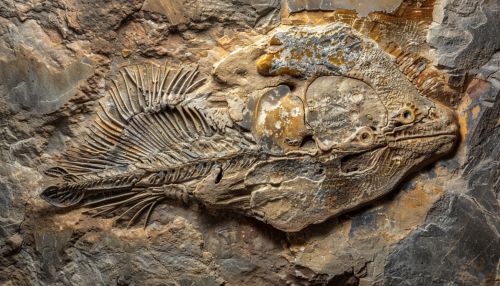Charopytha
Introduction
Charopytha is a term used to describe a specific group of ancient, extinct organisms that played a significant role in the evolutionary history of life on Earth. These organisms are primarily known from the fossil record and are of interest to paleontologists and evolutionary biologists due to their unique characteristics and their place in the tree of life. This article delves into the taxonomy, morphology, ecology, and evolutionary significance of Charopytha, providing a comprehensive overview of current scientific understanding.
Taxonomy and Classification
Charopytha belongs to the domain Eukaryota, characterized by cells with a nucleus enclosed within membranes. Within this domain, Charopytha is classified under the kingdom Plantae, although its exact phylogenetic position remains a subject of ongoing research. The classification of Charopytha is based on morphological and genetic evidence obtained from fossil specimens.
Phylogenetic Relationships
The phylogenetic relationships of Charopytha are complex and have been the subject of numerous studies. Charopytha is believed to share a common ancestor with other early plant groups, such as the bryophytes and pteridophytes. Molecular phylogenetics and comparative morphology have been instrumental in elucidating these relationships, although some aspects remain contentious.
Morphology
The morphology of Charopytha is characterized by several distinctive features that set it apart from other early plant groups. These features include unique reproductive structures, specialized cells, and specific growth patterns.
Reproductive Structures
Charopytha exhibits a variety of reproductive structures, including spores and gametangia. The spores are typically encased in a resistant outer layer, which has allowed them to be well-preserved in the fossil record. The gametangia are specialized organs that produce gametes, and their structure can provide insights into the reproductive strategies of Charopytha.
Specialized Cells
The cells of Charopytha show a high degree of specialization, with distinct cell types adapted for various functions. These include photosynthetic cells, structural cells, and reproductive cells. The presence of specialized cells suggests a level of complexity in Charopytha that is comparable to modern plants.
Ecology
Charopytha occupied a variety of ecological niches, ranging from aquatic to terrestrial environments. Their ability to adapt to different habitats is reflected in the diversity of their morphological and physiological traits.
Aquatic Habitats
In aquatic habitats, Charopytha likely played a role similar to that of modern algae, contributing to primary production and forming the base of the food web. Fossil evidence suggests that some species of Charopytha were adapted to life in shallow marine environments, where they would have been exposed to varying levels of light and nutrients.
Terrestrial Habitats
The transition of Charopytha to terrestrial habitats represents a significant evolutionary milestone. This transition required adaptations to desiccation, UV radiation, and nutrient acquisition from the soil. The fossil record provides evidence of these adaptations, including the development of cuticles and stomata.
Evolutionary Significance
The evolutionary significance of Charopytha lies in its role as a precursor to more complex plant groups. The study of Charopytha provides valuable insights into the early stages of plant evolution and the adaptations that allowed plants to colonize land.
Early Plant Evolution
Charopytha is considered one of the earliest groups of plants to exhibit key traits associated with terrestrial life. These traits include the development of vascular tissues, which allowed for the efficient transport of water and nutrients, and the evolution of complex reproductive structures.
Adaptations to Terrestrial Life
The adaptations of Charopytha to terrestrial life are of particular interest to evolutionary biologists. These adaptations include the development of structures to prevent water loss, such as cuticles and stomata, as well as mechanisms for nutrient acquisition and support.
Fossil Record
The fossil record of Charopytha is extensive, with specimens found in various locations around the world. These fossils provide valuable information about the morphology, ecology, and evolutionary history of Charopytha.
Notable Fossil Sites
Several notable fossil sites have yielded well-preserved specimens of Charopytha. These sites include the Rhynie Chert in Scotland, which is renowned for its exceptional preservation of early plant fossils, and the Burgess Shale in Canada, which has provided insights into the diversity of early life.


Fossil Preservation
The preservation of Charopytha fossils is often attributed to rapid burial in sediment and the presence of mineral-rich waters, which facilitated the fossilization process. The detailed preservation of these fossils has allowed scientists to reconstruct the morphology and ecology of Charopytha with a high degree of accuracy.
Research and Discoveries
Research on Charopytha has been ongoing for over a century, with significant discoveries made in recent decades. Advances in technology, such as scanning electron microscopy and molecular analysis, have provided new insights into the biology and evolution of Charopytha.
Technological Advances
Technological advances have played a crucial role in the study of Charopytha. Techniques such as scanning electron microscopy have allowed for the detailed examination of fossil structures, while molecular analysis has provided information on the genetic relationships between Charopytha and other plant groups.
Recent Discoveries
Recent discoveries have shed light on the diversity and complexity of Charopytha. These discoveries include the identification of new species, the reconstruction of ancient ecosystems, and the elucidation of evolutionary relationships.
Conclusion
Charopytha represents a key group in the evolutionary history of plants, providing valuable insights into the adaptations that allowed plants to colonize terrestrial environments. The study of Charopytha continues to be a dynamic field, with ongoing research uncovering new information about these ancient organisms.
See Also
- Bryophyta
- Pteridophyta
- Rhynie Chert
- Burgess Shale
- Scanning Electron Microscopy
- Molecular Phylogenetics
